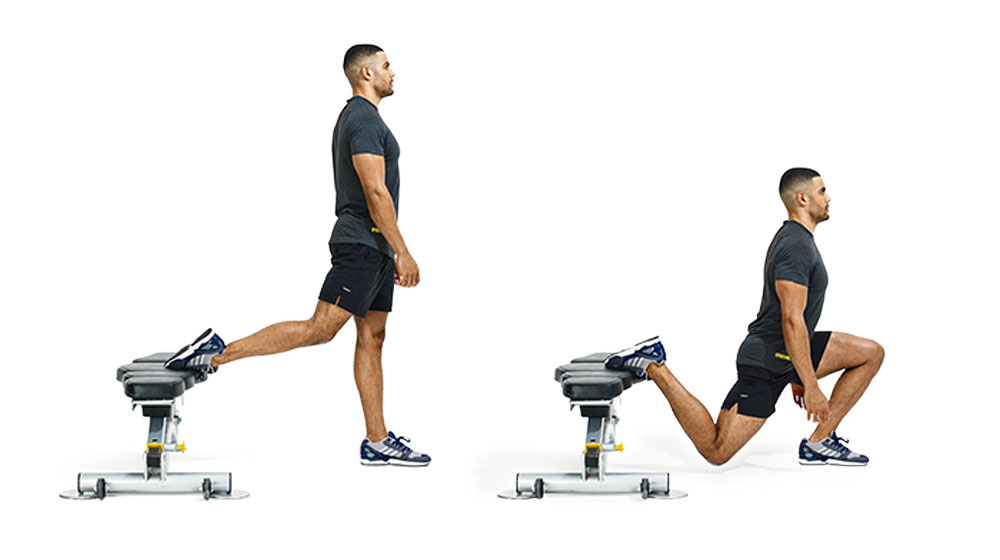Athletes are required to perform explosive powerful movements during sport. The hip muscles, including the gluteus medius, help generate and transfer forces during sport-specific activities such as running, cutting, and throwing. These types of athletic demands require high intensity training in the gym. Gluteus medius exercise which emphasize multiple planes of movement in single-leg or asymmetrical stances are advantageous for these demands.
The advanced exercise progressions included here should first be performed in a slow and controlled manner with an emphasis on technique. As technique becomes adequate, the speed of movement and load can be increased. Under any conditions, control of the movement and body positions are extremely important. Remember, the primary function of the gluteus medius is to stabilize and control the position of the pelvis. This is mandatory for the rest of the body to generate, transfer, and dissipate forces optimally.
Skater Squat
The skater squats begins by standing on one leg and performing a squat to a comfortable depth. The depth is determined by the ability to maintain balance and good control of the trunk and entire lower extremity. The non-weight bearing leg extends at the hip and flexes at the knee. The torso slightly twists and the arms swing reciprocally as if skating. The toe of the non-weight bearing leg can touch the floor between repetitions if needed. Hold the downward position for 2 seconds then return to the starting position. Challenge to the gluteus medius can be increased by placing a resistance band around the thighs just above the knees.
Transverse Lunge
The transverse lunge starts standing with the feet near each other and hands on the hips. Throughout the exercise the trunk is maintained in an upright position, so the knee and hip of the lunging leg can be flexed to 90°. This prevents the knee from moving forward past the toes. Also, the knee remains over the toes so it does not cave inwards into valgus. During the transverse lunge, the body is rotated 135° towards the lunging side. This involves twisting behind the body and lunging in one motion. Challenge to the gluteus medius can be increased by holding a dumbbell or kettlebell in the hand opposite the lunging leg.
Rear Foot Elevated Split Squat
The rear foot elevated, or Bulgarian, split squat is an excellent exercise to target the gluteus maximus, gluteus medius, quadriceps, and hamstring muscles. For this exercise, the rear foot is placed up on a 6 to 12 inch step or box. The supporting leg should be positioned approximately one leg length in front of the box or step. This may need to be adjusted based on comfort and balance. However, it is important that the hip and knee of the front leg is able to flex to 90 degrees during the movement.
It is also important to maintain good upper body posture with a natural curve in the low back and the chest up. This position should be maintained during the descent and ascent of the movement. Excessive trunk flexion or side bending are common errors. The front knee should not move forward past the toes. The knee should remain over the toes so it does not cave inwards into valgus. Perform 8 to 10 slow and controlled repetitions before switching sides to the other leg. Challenge to the gluteus medius can be increased by holding a dumbbell or kettlebell in the hand opposite the front leg.
Lateral Step Down
The step down exercise begins with the hands on the hips standing with one leg on the side of a step or 8-inch high box. Maintain balance on 1 leg and slowly squat to lower the heel of the other leg toward floor. Gently tap the heel and return to the start position. Throughout the exercise the trunk is maintained in an upright position. Avoid leaning the trunk to the side or waving the arms. The knee should not move forward past the toes. Also, the knee should remain over the toes so it does not cave inwards into valgus. Perform 8 to 10 slow and controlled repetitions before switching sides to the other leg.
1-Leg Squat
If the lateral step down can be performed with proper form, the next challenge is to progress to performing a single-leg squat. Begin by balancing on one leg with the hands on the hips. The non-weight bearing knee and hip are flexed in front to approximately 30°. Slowly lower toward the floor being sure to maintain control of the trunk and supporting leg. The depth of the squat is determined by the ability to maintain balance and control the movement. Return to the starting position and keep the knees over the toes to prevent knee valgus throughout the exercise. This exercise can be performed with or without the assist of a chair. Many times the chair is needed initially until control and strength improve. Challenge to the gluteus medius can be increased by holding a dumbbell or kettl bell in the hand opposite the supporting leg.
Closing Thoughts
These five exercises require practice to perfect. Often, a trainer or physical therapist is needed to coach an individual through these types of exercises. These are higher level exercises which are not for everyone. However, mastering these types of dynamic movements often translate to improved coordination, strength, and power on heavier compound lifts such as the squat or deadlift. Team sport athletes often see improvements in explosiveness and agility on the field. Unfortunately, many become frustrated with the amount of practice and effort it takes to perform these types of exercises. If needed, regress back to perform less challenging exercises in non-weight bearing (here) or weight bearing positions (here). This is all part of the process. Be patient and stick with it and you will see results down the road.

